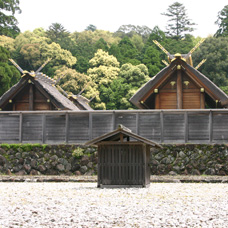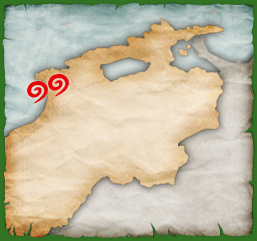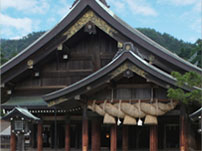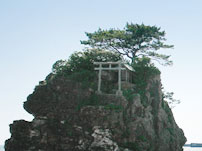Sengu
- What is Sengu?
- Architectural Details
- Process
- Ise Connection
Ise Connection
Written by Dustin Kidd
2013 is also the year in which Ise Jingu (The Grand Shrine of Ise) will hold its latest sengu. Throughout its history, Ise Jingu has held a sengu every 20 years, and 2013 marks its 62nd sengu. In an Ise Jingu sengu, all of the shrines on its grounds are completely rebuilt. The shrines all have open spaces directly next to the ones where the current shrine buildings stand; these spaces, being of exactly the same size, are where the shrines are rebuilt. Although this style of sengu is quite different from that of Izumo Taisha, the concept behind both kinds of sengu remains the same: a renewal of the shrine’s energy. They also preserve the traditional methods of shrine architecture for future generations.
Ise Jingu and Izumo Taisha, as two of the most important shrines in Japan, share some significant connections. In the Kuniyuzuri myth, which describes why Izumo Taisha was built, Amaterasu sends messengers down to Ashihara-no-nakatsukuni to tell Okuninushi to turn over control of those lands to her. The fact that they appear in The Kojiki means that both Amaterasu and Okuninushi are ancient and important deities. Amaterasu is enshrined in the inner shrine of Ise Jingu, and Okuninushi is enshrined in Izumo Taisha.
The idea of sengu has both a cultural and spiritual significance here, and seeing a sengu is one way to gain a deeper understanding of Japan. While Ise Jingu’s sengu has generally followed a regular 20-year cycle, Izumo Taisha’s sengu has not always been held every 60 years. A year in which both shrines have a sengu is extremely rare, making 2013 an exceptionally good year to visit Japan and learn more about the culture here, and visiting both Shimane and Ise Jingu will offer a more varied perspective on sengu and the role it plays.

Each of the individual shrines on the grounds of Ise Grand Shrine has a separate area set aside nearby for its sengu, which happens every 20 years.
- Dustin Kidd, Japanese Cultural Scholar
- Author of “Oi Genki Ka!?”, a collection of essays about life in Japan and “San-in English School”, a daily column about different facets of life in the San-in Region of Japan, which ran from Oct. 2009 to Mar 2011.
Lecturer: “Comparing Japanese and Greek Mythology”, “Experiences with Shinto”, “The Appeal of Shinto and Buddhism.”
Visiting Locations connected to Izumo Taisha
Izumo Taisha is located on the western end of the Shimane Peninsula, in the Taisha area of Izumo City. A large shrine gate, said to be the largest in Japan, towers over the main road to Izumo Taisha and welcomes visitors to the area. Izumo Taisha is easily accessible by car, bus, or train, and the area around the shrine bustles with tourists and visitors to the shrine, especially on the weekends.
If you follow the road that passes in front of the shrine grounds, you will soon arrive at Inasa-no-Hama beach. This beach is part of Sono-no-nagahama, a place that plays a large role in the Kunibiki legend, and is where Takemikazuchi presented Okuninushi with his demands to turn over Ashihara-no-nakatsukuni to Amaterasu, and where Takeminakata challenged him to a test of strength. It is also where, every year at the Kami-mukae-sai, all of the gods from around Japan are welcomed to Izumo Taisha, and the procession back to Izumo Taisha from the beach follows a path through town along the Kami Mukae Road.


Izumo Taisha
195 Kizukihigashi, Taisha-cho, Izumo City, Shimane

Inasa-no-Hama
Kizukikita, Taisha-cho, Izumo City, Shimane













